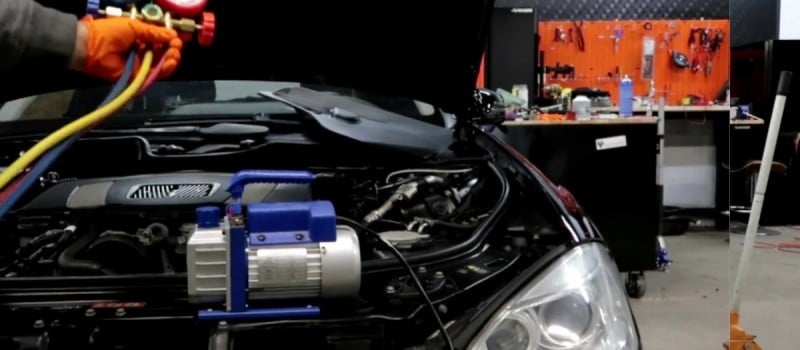Charge Mercedes-Benz A/C with Refrigerant
Is your Mercedes-Benz A/C blowing hot air even if the temperature is set too cold? Learn how to fix the problem by recharging your Mercedes-Benz’s A/C system with a refrigerant. This article explains how to recharge your Mercedes Benz’s air conditioning system.
Working on your Mercedes Benz’s air conditioning system is time-consuming but not difficult. The only downside is the high equipment price, such as the AC vacuum pump and the R124a refrigerant.
If you are a DIYer with the guts and willing to trade money for knowledge,
you may follow our instructions below to jumpstart your quest for practical knowledge on Mercedes Benz airconditioning systems.
What you will need
Tools
- Gloves
- Eye Protection
- Nozzle
- Air conditioning Manifold gauges
- Scale
- UV dye
- Cabin Thermometer
Parts
- Refrigerant
Procedure
Test the A/C System for leaks.
You should test for leakage if your A/C system is losing cooling ability.
- Locate the A/C compressor. Follow the lines from the A/C compressor until the access ports are found. Each access port will be labeled differently. One would be labeled H, which represents the High-pressure side, while the other would be labeled L, which stands for Low and represents the Low-pressure side. Unscrew the valve covers for each port. Listen to any sound of escaping air from the Schrader valve cover as you remove it. It may indicate a leak that may empty your refrigerant over time.
- If the hoses from the manifold gauges are not connected, connect the blue hose to the blue gauge, the red hose to the red gauge, and the yellow hose to the center of the manifold.
- Close all the valves on the manifold gauge side before proceeding.
- Connect the red hose (high pressure) to the bigger port of the A/C system and the blue hose (low pressure) to the smaller port of the A/C system. Note: There are two types of manifold connectors: the snap-on type and the valve control type with individual valves. To connect the snap-on type, press the connector to the port, and it will automatically lock and open the Schrader valve. To connect the valve-type connector, snap the connector onto the valve, then open the attached valve to open the Schrader valve.
- The gauges would show the static pressure on each side as soon as the hoses are connected to the manifold gauge.
- Measure the dynamic pressure in the system by starting the engine and turning on the A/C to the lowest level. Wait for the compressor to kick in, and then the dynamic A/C pressure will be displayed on the gauges.
- Observe the pressure reading on the High-pressure side. Depending on the ambient temperature, it should be at 150 to 200 psi. The low side should be at 30 psi.
- If the pressure falls below the specifications, the A/C refrigerant is low. Low refrigerant means that there is a leak somewhere in the A/C system.
- Trace the leak from the System by adding a UV dye. Turn on the engine and turn on the A/C, hook the UV dye on the low side port, then release its contents for 3 seconds to introduce the dye into the system. Wait until the dye on the transparent hose of the dye applicator is used up. Turn off the garage light, then use a UV flashlight to find any trace of the dye along the A/C line.
- If the UV dye shows up on lines, fittings, or even valves, remove the refrigerant from the system by following the steps in this article’s “Remove the refrigerant from the system” section.
- If the leak is found on a line, replace the entire line and gaskets with a new one.
- If the leak is on the gasket, replace the gasket with a new one.
- If the leak is on the Schrader, then replace the valve.
Note: This article does not cover detailed steps for removing and replacing A/C components. However, we will create articles on this topic in the future.
Remove the refrigerant from the system by following the instructions below.
- Removing A/C refrigerant by yourself is illegal. It is recommended that you take your car to a professional for proper disposal. Before following the steps below, have a professional drain your car’s refrigerant. Note: The steps below are designed to remove your system’s remaining air and moisture.
- Ensure that the vacuum pump has enough oil. Open the filler cap located on top of the pump; check the oil level by matching it against the filler line. If the oil is low, add some oil until it reaches the line. Note: Only use oil is designed for vacuum pumps.
- Attach the gauges to their respective ports. Make sure that the gauge’s valves are closed before proceeding. Connect the gauges to each hose using the hose color and gauge color as a reference. Connect the red hose to the car’s high-pressure port, the blue to the low-pressure port, and the yellow to the vacuum pump. Hold the connector with the palm and a finger on the lock to connect the manifold connector to the car’s aircon ports. Press the lock, insert the connector into the port, and then release the lock. Note: Hoses going to the car are sized differently, and there is no risk of interchanging the hoses.
- Start the pump.
- Turn all the valves open by following the labels on the valves. This will allow refrigerant air and moisture to be sucked out of the system. The vacuum sound should be heard.
- Monitor the gauges and ensure that the blue gauge slowly turns in the reverse direction from an initial value.
- Once the value on the blue gauge reaches -30 psi, turn off the vacuum.
- Close the gauge’s low and high side valves and wait for fifteen to thirty minutes. Check for leaks if the vacuum does not hold for fifteen to thirty minutes.
- Turn on the vacuum pump. Let it run for 40 more minutes and open the gauge’s valves.
- Close the gauge’s valves, then turn off the vacuum pump.
- Disconnect the vacuum line. Your air-con system is now ready to be recharged.
- Dispose of the old refrigerant properly.
Recharge the Airconditioning System by following the instructions below
- You can find the sticker on the hood or near the front grill, indicating the recommended quantity (in kgs or pounds) and type of refrigerant your car is using.
- Buy a refrigerant with the same type and quantity indicated on the sticker. If the quantity on the refrigerant container is less than the required quantity, buy more refrigerant containers until the sum of the contents is equal to or greater than the required quantity. Note: When choosing refrigerants, choose refrigerants with added oil; this oil would help lubricate the air conditioner compressor. DO NOT choose refrigerants with leak sealers. This would do more damage to the air conditioner system.
- Remove the hose from the vacuum pump, then put some UV dye in the hose.
- Attach the air conditioning loading nozzle to the refrigerant by screwing it into the can.
- Connect the yellow hose to the other port of the nozzle.
- Screw down the nozzle’s valve to puncture the can.
- Loosen the nozzle’s top valve to release the contents of the refrigerant can.
- Purge the system’s remaining air and moisture by pressing the gauges’ release valve with a Phillips screwdriver for three seconds.
- Start the engine.
- Turn on the aircon and set the fan speed to low. This process would let the compressor turn and suck refrigerant in.
- Insert a thermometer to the nearest aircon vent inside the cabin. Note: the temperature reading would go up.
- Open the Low side (blue) valve of the gauge. Note: Place the can on a cool surface to avoid heating the refrigerant, which may cause an explosion.
- Once the compressor kicks in, it will suck the refrigerant into the system. Notice that the low-pressure side gauge would go down while the high side gauge would slowly go up.
- To ensure the refrigerant can is empty, shake the can while looking at the watch glass between the two gauges.
- If there is no more refrigerant in the can, close the low side gauge’s low side valve (blue); then close the nozzle valve and unscrew the can.
- Reconnect the nozzle to the refrigerant and place the can on top of a weighing scale to verify the remaining refrigerant to fill up the system.
- Open the nozzle’s valve and open the gauge’s low-side valve.
- Let the refrigerant go into the system until the calculated remaining weight is consumed.
- Shut off the Gauge’s valves.
- Shut off the manifold gauges, then disconnect the hoses from the car.
- Screw the caps on the a/c lines. Do not tighten them too hard.
- Check the temperature reading from the cabin; it should be forty to forty-three degrees Fahrenheit.
Important: Always wear eye protection and gloves when working with refrigerants. This would ensure your safety when accidental exposure occurs.
Frequently Asked Questions
How long does recharging AC last?
Your air conditioning does not run constantly, so unless your A/C system leaks, you can usually expect a recharge to last at least three years or longer.
How much does it cost to recharge AC in Mercedes?
It will cost around $200 – $300. Price parts for $70-100, while labor costs around $150 – $250.
Why is my car AC blowing hot air?
One cause of why your vehicle’s AC blows hot air is because of a low refrigerant level or refrigerant leak.
How long does recharging the AC last?
- Your air conditioning does not run constantly, so unless your A/C system leaks, you can usually expect a recharge to last at least three years or longer.
We hope you find the Charge Mercedes-Benz A/C with Refrigerant guide helpful. Check these troubleshooting and repair guides for more help on your Mercedes-Benz.









